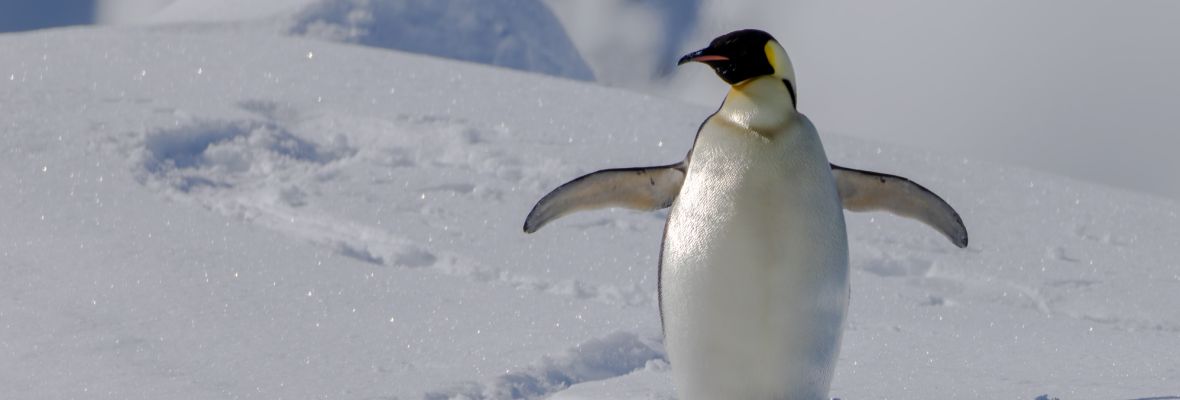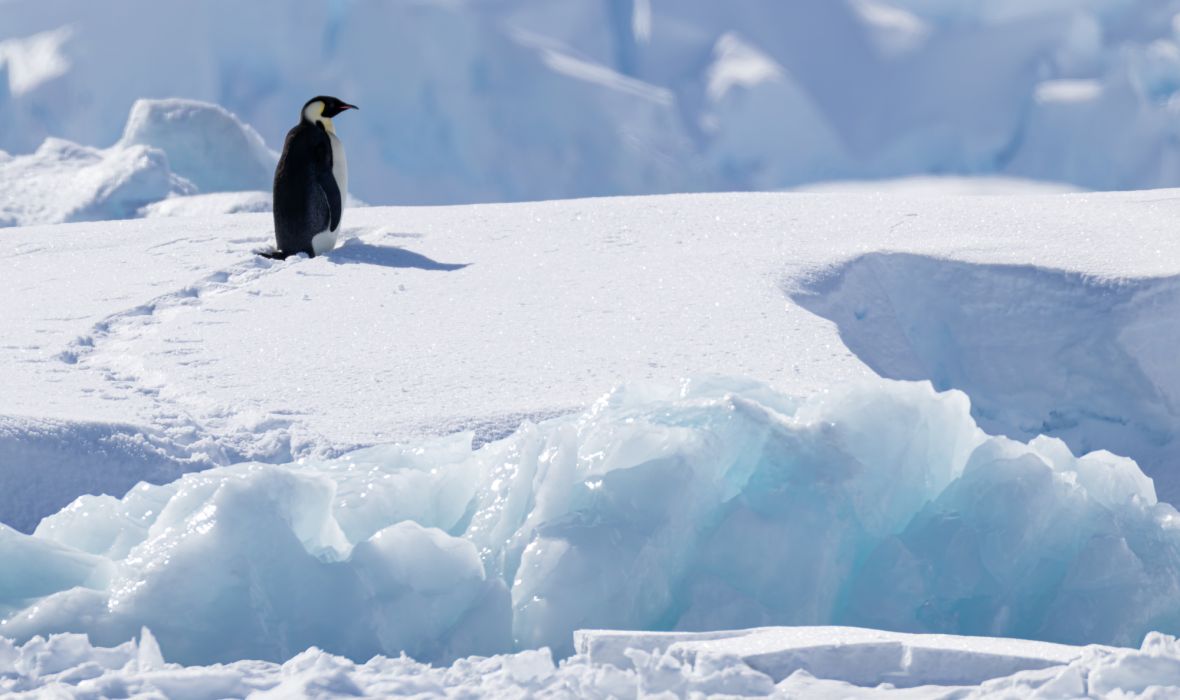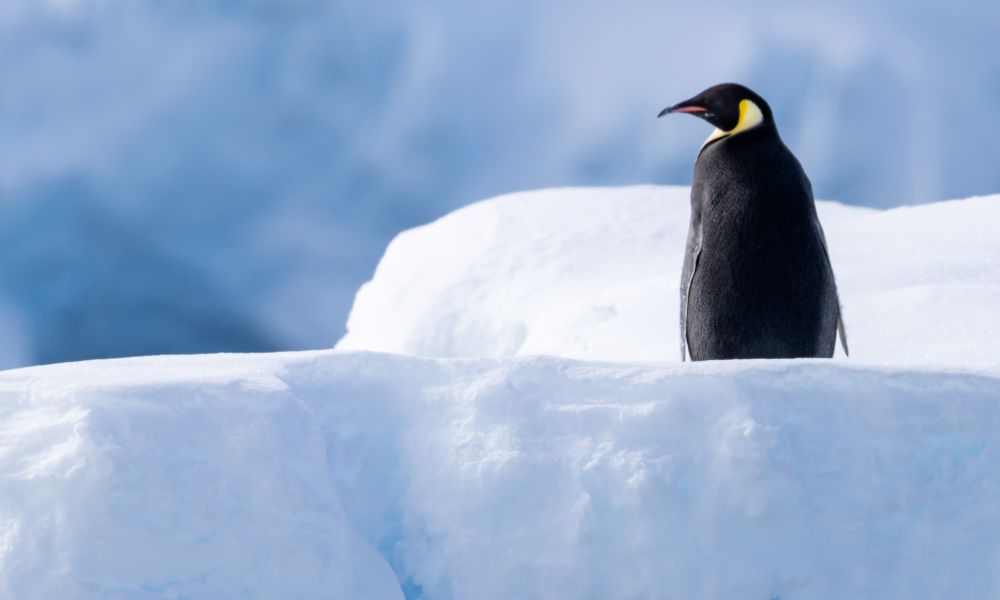Exciting changes are on the way!
As part of our merger with Polar Latitudes, we’re refreshing key elements of our website to reflect this new chapter. Discover more in our latest news update.

Emperor Penguin
Scientific Name: Aptenodytes forsteri
Population: Estimated at ~500,000 individuals globally
Regions: Antarctica
Destinations: South Shetland Islands, Antarctic Peninsula, South Georgia
Average Length: Adult: Males: ~1.20–1.25 m (3.9–4.1 ft), Females: ~1.10–1.20 m (3.6–3.9 ft); Newborn: ~30–35 cm (1–1.1 ft)
Average Weight: Adult: Males: ~38–45 kg (84–99 lbs); Females: ~25–35 kg (55–77 lbs); Newborn:~315–500 g (0.7–1.1 lbs)
Diet Habits: Primarily fish, cephalopods and crustaceans
Kingdom: Animalia
Phylum: Chordata
Class: Aves
Order: Sphenisciformes
Family: Spheniscidae
Genus: Aptenodytes
Species: Aptenodytes forsteri
English: Emperor Penguin
Danish: Kejserpingvin
Chinese: 皇帝企鹅
Swedish: Kejsarpingvin
Finnish: Keisaripingviini
Norwegian: Keiserpingvin
Polish: Pingwin cesarski
Japanese: コウテイペンギン
Spanish: Pingüino emperador
French: Manchot empereur
Frequently Asked Questions About the Emperor Penguin
How tall is an emperor penguin?
The emperor penguin height is up to 125 cm (4.1 ft) tall. Its size is so remarkable that if you place an emperor penguin next to a human, it can be almost as tall as a young child!
How much do they weigh?
Emperor penguins weigh between 22 and 45 kg (49–99 pounds), making them the largest and by far the heaviest of all penguins. However, during incubation period males can lose nearly half of their body weight size.
What does an emperor penguin eat?
The emperor penguin diet is mainly based on fish, cephalopods, and crustaceans. Uniquely among birds, males can produce a nutritious, milk-like substance to feed their chicks if the female hasn’t returned from the sea, which is a highly unusual trait.
Where does the emperor penguin live?
The emperor penguin habitat is usually the pack ice near the coast of Antarctica. On our ships, you can spot these lovely penguins in areas such as the South Shetland Islands, Antarctic Peninsula, and South Georgia!
What’s the difference between a king penguin and an emperor penguin?
Even though these two precious penguins are very similar to each other and can often be mistaken for one another during our voyages, they have many differences. The emperor species is larger but has shorter bills and flippers compared to the king penguin. Also, emperor penguins have yellow-orange patches on their necks with a black collar, whereas the king penguin has brighter orange and yellow ear patches along with a more orange chest. Lastly, while emperor penguins breed on the Antarctic ice, king penguins are found on the sub-Antarctic islands.
How long does an emperor penguin live?
Emperor penguin lifespan ranges from 15 to 20 years, but they may live much longer.
Who are their main predators?
Emperor penguin predators in the sea are usually killer whales and leopard seals, while on land they include the Southern giant petrels and South polar skuas, which prey on weak or dead emperor penguin chicks.
Is the emperor penguin endangered?
According to the IUCN Red List of Threatened Species, they are classified as ‘Near Threatened’, with their population declining over the years.

How Many of These 10 Emperor Penguin Facts Did You Already Know?
Fact #1: In May and June, they lay a single large egg weighing nearly half a kilogram.
Fact #2: Their nesting occurs on stable pack ice close to the Antarctic coast.
Fact #3: The male species incubates the egg for two months during the cold and harsh winter months.
Fact #4: Emperor penguin's baby size is quite small (10cm, 365 grams) despite its large adult size.
Fact #5: One of the most characteristic adaptations of emperor penguins is that they are the only penguin species that breed during the Antarctic winter.
Fact #6: Emperor penguin sounds are high-pitched, deep, and resemble trumpets, which are vital within their crowded colonies for recognising each other and locating the baby emperor penguins.
Fact #7: They don't build nests. Instead, they place the egg on their feet, covered by a skin fold to keep it warm.
Fact #8: In sporadic cases, the emperor penguin's life expectancy can be up to 50 years!
Fact #9: The emperor king's life cycle involves breeding during the winter.
Fact #10: Male size can diminish by half of its original weight during egg incubation.
Join on an Antarctica adventure with Albatros Expeditions and witness the wonders of Antarctica wildlife!




